Task Factory Address Management
Address Verification Connection Manger
| Icon | Description |
|---|---|
|
|
The Address Verification Connection Manager is used to connect to your USPS database and Assemblies. |

| Option | Description |
|---|---|
| Database Location | The file path to the dvd_comm extracted folder. Selectto open the Browse For Folder window, and then select the appropriate file path. Select OK to save your connection. |
| Assemblies Location | The file path to the ams_devkit extracted folder. Selectto open the Browse For Folder window, and then select the appropriate file path. Select OK to save your connection. |
Address Parse Transform
| Transform Icon | Transform Description |
|---|---|
|
|
The Address Parse Transform is used to parse unformatted address data and transforms it into USPS standardized address data. |
Address Data Input

Input Options
| Option | Description |
|---|---|
| Single column contains all address data | Use this option when all of the address data from your source is contained in a single column. |
| Address data is spread across multiple columns | Use this option when the address data from your source is not contained in a single column. You choose which column from your source contains the address element needed by the transform. |
Use the address data input tab to map the source input columns to the appropriate address elements in the address parse transform. Your source does not have to contain a one to one relationship to the address elements in the address parse. You can map a single column from your source to multiple address elements in the transform. For example:
| AddressLine1 column: | Address |
| AddressLine2 column: | Address |
| City column: | CityStateZip |
| State column: | CityStateZip |
| PostalCode column: | CityStateZip |
Address Quality

The address parse assigns a level of quality to two sections of the address:
- Address Line 1 and Address Line 2
- City, State, and Zip
There are three levels of quality that can be assigned to the two sections of an address:
| High | Medium | Low |
|---|---|---|
|
|
|
When the address parse runs it parses out the data and assigns the level of quality based on whether it can find a valid address and a valid city, state, and zip according to the rules above. You can either include all of the address as part of the output from the transform or you can select Include only high quality parsed addresses. Selecting this means that the output named Parsed Address Output contains addresses that are considered high quality. If you choose this option you must also make a selection from the What should happen to non-parseable (low quality) addresses? drop down menu.
| Option | Description |
|---|---|
| Ignore Failures | This option skips the addresses marked as low quality. |
| Redirect Errors to Error Output | This option redirects the rows to the error output. |
| Fail Component | This option fails the component when the first invalid address is found. |
| Redirect Errors to Non-Parseable Output | This option redirects the rows to the Non-Parsed Address Output. |
Parsed Output

The Parsed Output tab defines how you want the parsed address data outputted from the transform. By default there are new columns for each address elements and quality elements as part of the Parsed Address Output.
Output Columns
| Column | Description |
|---|---|
| Address Data Column | The address data column defines the data that is output from the transform. |
| Action Column | The action column defines whether the output contains a new column or the data in an existing column.
|
| Output Column Name | Defines either the name of the output column if Add New Column is selected in the Action column or the name of the source column to replace if Replace Column is selected. |
| Output Data Type | Choose the output data type. |
| Output Length | Define the length of the column. |
| Code Page | Change the code page. |
| Output Case Formatting | Defines how the output is determined:
|
Address Verification Transform
Address Verification Transform must be run in 32-bit mode. An internet connection is required to update the Address Verification database.
| Transform Icon | Transform Description |
|---|---|
|
|
The Address Verification Transform uses the USPS database to verify United States addresses. |
Source Data

| Option | Description |
|---|---|
| Connection Manager | Select the Connection Manager for the Address Verification Transform. |
| Firm Name Source Column | (Optional) Maps the column that contains the person or firm's name. |
| Address1 Source Column | (Required) Maps the column that contains the first address line. |
| Address2 Data Column | (Optional) Maps the column that contains the second address line (e.g. suite or apartment numbers, building name, etc.) |
| City Source Column | (Required) Maps the column that contains the city. |
| State Source Column | (Required) Maps the column that contains the state. |
| Zip Code Source Column | (Required) Maps the column that contains the zip code. |
| Urbanization Source Column | (Optional) Maps the column that contains the urbanization code for Puerto Rico addresses. |
| Unverified Address Behavior | Options for handling unverified addresses:
|
Output Columns

| Option | Description |
|---|---|
| Address Data Column | Identifies the column. |
| Column Behavior | Users can choose between the following:
|
| Output Column Name | Users can change the name of the output column. |
The following list details the Address Verification Transform's output:
|
Column Name |
Data Type |
Length |
|
AddressLine1 |
DT_WSTR |
255 |
|
AddressLine2 |
DT_WSTR |
255 |
|
City |
DT_WSTR |
255 |
|
State |
DT_WSTR |
3 |
|
ZipCode |
DT_WSTR |
10 |
|
ResponseCode |
DT_I1 |
0 |
|
AbbreviatedCity |
DT_WSTR |
255 |
|
AddressComponentChanged |
DT_BOOL |
0 |
|
AddressKey |
DT_WSTR |
255 |
|
AddressNotFound |
DT_BOOL |
0 |
|
AddressStandardized |
DT_BOOL |
0 |
|
AllOrPartFirmLineUsedForAddressLine |
DT_BOOL |
0 |
|
BetterAddressExists |
DT_BOOL |
0 |
|
CarrierRoute |
DT_WSTR |
255 |
|
CarrierRouteRateSortIndicator |
DT_WSTR |
255 |
|
CityStateCorrected |
DT_BOOL |
0 |
|
CountyCode |
DT_WSTR |
255 |
|
DeliveryPoint |
DT_WSTR |
255 |
|
FirmName |
DT_WSTR |
255 |
|
FirstPostDirection |
DT_WSTR |
255 |
|
FirstPreDirection |
DT_WSTR |
255 |
|
FirstSuffix |
DT_WSTR |
255 |
|
IncorrectSecondaryNumber |
DT_BOOL |
0 |
|
InsufficientIncorrectData |
DT_BOOL |
0 |
|
InvalidCityStateZip |
DT_BOOL |
0 |
|
LookupStatus |
DT_WSTR |
255 |
|
MainPostOfficeOutputCity |
DT_WSTR |
255 |
|
MainPostOfficeOutputState |
DT_WSTR |
255 |
|
MatchedPrimaryNumber |
DT_WSTR |
255 |
|
MatchedSecondaryNumber |
DT_WSTR |
255 |
|
MilitaryMatch |
DT_BOOL |
0 |
|
MissingSecondaryNumber |
DT_BOOL |
0 |
|
MultipleResponseCanBeBrokenUsingTheLowestZip4 |
DT_BOOL |
0 |
|
MultipleResponseDueToMagnetStreetSyndrome |
DT_BOOL |
0 |
|
NoMatchDueToEws |
DT_BOOL |
0 |
|
NonPoBoxDualAddress |
DT_BOOL |
0 |
|
NoZip4Assigned |
DT_BOOL |
0 |
|
PoBoxDualAddress |
DT_BOOL |
0 |
|
PrimaryName |
DT_WSTR |
255 |
|
PrimaryNumber |
DT_WSTR |
255 |
|
RuralRouteNumber |
DT_WSTR |
255 |
|
SecondaryNumber |
DT_WSTR |
255 |
|
SecondaryNumberUnit |
DT_WSTR |
255 |
|
SecondPostDirection |
DT_WSTR |
255 |
|
SecondPreDirection |
DT_WSTR |
255 |
|
SecondSuffix |
DT_WSTR |
255 |
|
SmallTownDefault |
DT_BOOL |
0 |
|
StandardizedOutputCityStateZip |
DT_WSTR |
255 |
|
StandardizedPrUrbanizationName |
DT_WSTR |
255 |
|
StreetNameChanged |
DT_BOOL |
0 |
|
UniqueZipCodeDefault |
DT_BOOL |
0 |
|
UniqueZipCodeMatch |
DT_BOOL |
0 |
|
UnofficialPostOfficeName |
DT_BOOL |
0 |
|
UnverifiableCityState |
DT_BOOL |
0 |
|
ZipCode4 |
DT_WSTR |
255 |
|
ZipCodeAssignedWithMultipleResponse |
DT_WSTR |
255 |
|
ZipCodeCorrected |
DT_BOOL |
0 |
|
ZipMoveMatch |
DT_BOOL |
0 |
USPS Database Installation and Updates
Previous customers that received updates through Pragmatic Works - the last update occurred in November of 2018. Per the USPS, databases must be updated within 105 days of the previous update to maintain access. It's recommended customers update their database as soon as possible through the USPS’s Electronic Product Fulfillment website to ensure they maintain access.
Setting up the USPS Database for Task Factory
Complete the following steps to update your USPS database and assemblies when using the Task Factory Address Verification component:
Step One : Download Assemblies and Database
- Log in to the
USPS’s Electronic Product Fulfillment website, and then download the following files:
- AMS Commercial DVD SHA-256
- AMS Developer Kit SHA-256
- DPV Developer Kit SHA-256

Step Two : DPV Extraction
- Extract dpv_devkit.tar to the desired directory.
- Run the gdev.exe application. Note: The gdev.exe application is located in the directory where dpv_devkit.tar was extracted.
- Select the W32 platform and then select all the files in the Select Files section.
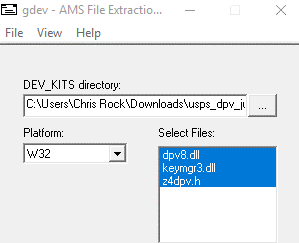
- Enter your USPS customer id for the W32 customer ID. Note: You may need to email the USPS support team for this step.
- Enter the destination directory. Important: Ensure you include the \ at the end of the path. For example, c:\usps\output\ .
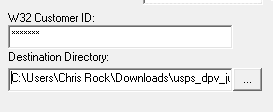
- Select Extract to proceed with the extraction. Note: You should receive this message:
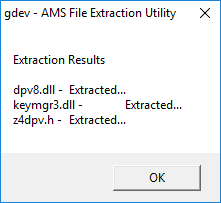
Step Three : AMS Extraction
- Extract the ams_devkit.tar file to the desired directory.
- Run the gdev.exe application. Note: The gdev.exe application is located in the directory where ams_devkit.tar was extracted.
- Select the W32 platform and then select all the files in the Select Files section.
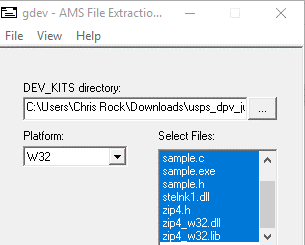
- Enter your USPS customer id for the W32 customer ID. Note: You may need to email the USPS support team for this step.
- Enter the destination directory. Important: Ensure you include the \ at the end of the path. For example, c:\usps\output\ .
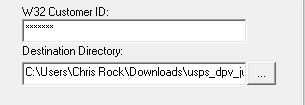
- Select Extract to proceed with the extraction. Note: You should receive this message
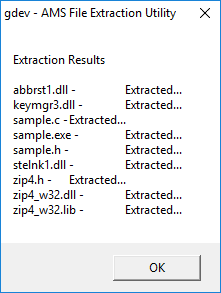
- Now copy the unencrypted files from both the AMS and DPV directories defined in the registry key HKEY_LOCAL_MACHINE\SOFTWARE\Sentry One\Task Factory\AmsDirectory. Note: You only need the .dll and .lib files.


Step Four : USPS Database Extraction
- Extract the contents of dvd_comm.tar to a temp directory.
- Rename the following:
- ams_comm directory to ams
- ams_dpv directory to dpv
- ams_elot directory to elot

3. Copy all of the directories from the temp directory to the directory defined in the registry key HKEY_LOCAL_MACHINE\SOFTWARE\Sentry One\Task Factory\AmsDbDirectory.
Understanding the USPS Address Verification Output
There are three outputs that are provided by the Address Verification Transform:
- Verified Address Output – This output includes all addresses that are returned from the USPS database as either a ResponseCode of 31 (single address found) or 32 (address found, but more accurate address could be located). See response status table for full descriptions.
- Invalid Address Output – This output includes all addresses that are returned from the USPS database with a response code of anything other than 31 or 32 .
- Multiple Address Output – This output includes the other addresses found when an address is returned with a status of 22 (multiple addresses found). The address record with a status of 22 sends out of the Invalid Address Output if the Unverified Address Behavior is set to Redirect unverified to unverified output in the:

- Error Output – This output contains any addresses where the data from the input column mapped to the Address 1 Source Column contains an empty or null value.
Output Columns
Verified Address Output Column Definitions
| Column Name | Definition |
|---|---|
|
AddressLine1 |
The standardized address line1 from the USPS database. |
|
AddressLine2 |
The standardized address line2 from the USPS database. |
|
City |
The standardized city from the USPS database. |
|
State |
The standardized state from the USPS database. |
|
ZipCode |
The standardized zip code from the USPS database. |
|
ResponseCode |
The response code returned from the USPS database. See Response Code Table for the codes and definitions. |
|
AbbreviatedCity |
The abbreviated city. |
|
AddressComponentChanged |
An address component (i.e., directional or suffix only) was added, changed, or deleted in order to achieve a match. |
|
AddressKey |
Internal address database key (for indexing). |
|
AddressNotFound |
Set to true if the address wasn’t found. |
|
AddressStandardized |
Set to true if the address was standardized. For example, if STREET was in the delivery address, the system returns ST as its standard spelling. |
|
AllOrPartFirmLineUsedForAddressLine |
Set to true if information in the firm line was determined to be a part of the address. It was moved out of the firm line and incorporated into the address line. |
|
BetterAddressExists |
Set to true if the delivery address can be matched, but is known by another (preferred) name. For example, in New York, NY, AVENUE OF THE AMERICAS is also known as 6TH AVE. An inquiry using a delivery address of 55 AVE OF THE AMERICAS would set this value to true. |
|
CarrierRoute |
The USPS 4 digit carrier rate code. |
|
CarrierRouteRateSortIndicator |
Set to A, B, C, or D :
|
|
CityStateCorrected |
The spelling of the city name and/or state abbreviation in the submitted address was found to be different than the standard spelling. The standard spelling of the city name and state abbreviation are shown in the output address. |
|
CountyCode |
The USPS county code for the address. |
|
DeliveryPoint |
The USPS delivery point for the address. |
|
FirmName |
The standardized firm name. |
|
FirstPostDirection |
First or Left Post-direction. |
|
FirstPreDirection |
First or Left Pre-direction. |
|
FirstSuffix |
First or Left Suffix. |
|
IncorrectSecondaryNumber |
Set to true if the secondary number was incorrect. |
|
InsufficientIncorrectData |
Set to true if Insufficient / Incorrect data is found. |
|
InvalidCityStateZip |
Set to true if an invalid city, state and zip was found. |
|
LookupStatus |
The return code value returned from the USPS database. |
|
MainPostOfficeOutputCity |
The city of the main post office for the standardized address. |
|
MainPostOfficeOutputState |
The state of the main post office for the standardized address. |
|
MatchedPrimaryNumber |
The primary address number. |
|
MatchedSecondaryNumber |
The primary secondary number. |
|
MilitaryMatch |
Set to true if a match was made with a military zip code. |
|
MissingSecondaryNumber |
Set to true if ZIP+4 information indicates this address is a building. The address as submitted does not contain an apartment/suite number. It is recommended that the requestor check the submitted address and add the missing apartment or suite number to ensure the correct Delivery Point Barcode (DPBC). |
|
MultipleResponseCanBeBrokenUsingTheLowestZip4 |
More than one ZIP+4 Code was found to satisfy the address as submitted. The lowest ZIP +4 add-on may be used to break the tie between the records. |
|
MultipleResponseDueToMagnetStreetSyndrome |
The search resulted in a single response; however, the record matched was flagged as having magnet street syndrome. “Whenever an input address has a single suffix word or a single directional word as the street name, or whenever the ZIP+4 File records being matched to have a single suffix word or a single directional word as the street name field, then an exact match between the street, suffix and/or post-directional and the same components on the ZIP+4 File must occur before a match can be made. Adding, changing or deleting a component from the input address to obtain a match to a ZIP+4 record will be considered incorrect.” Instead of returning a no match in this situation a multiple response is returned to allow access the candidate record. |
|
NoMatchDueToEws |
Set to true if the delivery address can be matched, but the EWS file indicates that an exact match will be available soon. |
|
NonPoBoxDualAddress |
CASS rule does not allow a match when the cardinal point of a directional changes more than 90%. |
|
NoZip4Assigned |
The ZIP Code in the submitted address could not be found because neither a valid city, state, nor valid 5-digit ZIP Code was present. It is also recommended that the requestor check the submitted address for accuracy. |
|
PoBoxDualAddress |
Set to true if the input contained two addresses. For example: 123 MAIN ST PO BOX 99. |
|
PrimaryName |
The primary street name. |
|
PrimaryNumber |
The primary street number. |
|
RuralRouteNumber |
The rural route number. |
|
SecondaryNumber |
The secondary number of the street address. |
|
SecondaryNumberUnit |
The secondary number unit of the street address. |
|
SecondPostDirection |
Second or Right Post-direction. |
|
SecondPreDirection |
Second or Right Pre-direction. |
|
SecondSuffix |
Second or Right Suffix. |
|
SmallTownDefault |
Set to true because of an invalid delivery address. The input address record contains a delivery address other than a PO BOX, General Delivery, or Postmaster with a 5-digit ZIP Code that is identified as a “small town default.” The United States Postal Service does not provide street delivery for this ZIP Code. The United States Postal Service requires use of a PO BOX, General Delivery, or Postmaster for delivery within this ZIP Code. |
|
StandardizedOutputCityStateZip |
The standardized city, state and zipcode. |
|
StandardizedPrUrbanizationName |
The standardized Puerto Rico urbanization. |
|
StreetNameChanged |
Set to true if the standardized address changed the street name. |
|
UniqueZipCodeDefault |
Set to true if a default match inside a unique ZIP Code. |
|
UniqueZipCodeMatch |
Set to true if an address with a unique ZIP Code was found. |
|
UnofficialPostOfficeName |
Set to true if the city or post office name in the submitted address is not recognized by the United States Postal Service as an official last line name (preferred city name), and is not acceptable as an alternate name. This does denote an error and the preferred city name will be provided as output. |
|
UnverifiableCityState |
Set to true if the city and state in the submitted address could not be verified as corresponding to the given 5-digit ZIP Code. This comment does not necessarily denote an error; however, it is recommended that the requestor check the city and state in the submitted address for accuracy. |
|
ZipCode4 |
The last 4 digits of the standardized address zip code. |
|
ZipCodeAssignedWithMultipleResponse |
Set to true if multiple records were returned, but each shares the same 5-digit ZIP Code. |
|
ZipCodeCorrected |
Set to true if the zip code was corrected when the address was standardized. |
|
ZipMoveMatch |
Set to true if the ZIPMOVE product shows which ZIP + 4 records have moved from one ZIP Code to another. If an input address matches to a ZIP + 4 record which the ZIPMOVE product indicates as having moved, the search is performed again in the new ZIP Code. |
Unverified Address Output
This output contains all the input column data along with a column named WhyInvalid which tells you why the address was deemed invalid by the USPS database.
Error Output
This output contains all the input column data along with a column named ErrorDescription which tells you input data was deemed invalid by the address verification transform.
Multiple Address Output
| Column Name | Description | ||||||||||||||
|---|---|---|---|---|---|---|---|---|---|---|---|---|---|---|---|
|
ActionCode |
A field indicating the action to be taken in updating the base master files. |
||||||||||||||
|
AddOnHigh |
The high-end ZIP add-on in a range of codes; the add-on of the last +4 code in a consecutive series of +4 codes assigned to the delivery address. Most delivery addresses are assigned a single +4 code; however, large companies may be given a range of +4 codes that can be used to route mail to specific departments. A range of +4 codes can also be assigned to a corresponding range of Post Office boxes, and each box is mapped, one-to-one, with a +4 code in the range. A single Post Office box can also be assigned a range of +4 codes. (See +4 Code.) Example: 12345-0001 through 12345-0009 => +4 High Number = 0009+4 codes associated with non-delivery areas are composed of valid ZIP™ sector numbers and “ND” for the ZIP segment number. Non-deliverable areas are areas to which the USPS does not deliver mail, such as vacant lots and land that borders railroad tracks. Mailers should not match an address identified as a non-delivery area. (See ZIP Sector Number or ZIP Segment Number.) |
||||||||||||||
|
AddOnLow |
The last four positions of a +4 code; the low-end +4 in a range of codes; the add-on of the first +4 code in a consecutive series of +4 codes assigned to the delivery address. For example, most delivery addresses are assigned a single +4 code. However, large companies may be given a range of +4 codes that can be used to route mail to specific departments. A range of +4 codes can also be assigned to a corresponding range of Post Office boxes, and each box is mapped, one-to-one, with a +4 code in the range. A single post office box can also be assigned a range of +4 codes. Example: 12345-0001 through 12345-0009 => +4 Low Number = 0001+4 Codes associated with non-delivery areas are composed of valid ZIP sector numbers and “ND” for the ZIP segment number. Non-deliverable areas are areas to which the USPS does not deliver mail, such as vacant lots and land that borders railroad tracks. Mailers should not match an address identified as a non-delivery area. (See ZIP Sector Number or ZIP Segment Number.) |
||||||||||||||
|
BaseAlternateCode |
Code that specifies whether a record is a base (preferred) or alternate record. Base records (represented as B) can represent a range of addresses or an individual address, such as a firm record, while alternate records (represented as A) are individual delivery points. Base Data Element Definitions Address Information System Products Technical Guide 62 records are generally preferred over alternate records. However, one exception is ZIP+4® product; in this file, government deliveries will only be listed on alternate records with the appropriate government building indicator (federal, state, or city) set. |
||||||||||||||
|
CarrierRoute |
A 4-byte code assigned to a mail delivery or collection route within a 5-digit ZIP™ Code. The first character of this identification is alphabetical, and the last three are numeric:
|
||||||||||||||
|
CongressionalDistrict |
A standard value identifying a geographic area within the United States served by a member of the U.S. House of Representatives. If Army/Air Force (APO), Fleet Post Office (FPO), or Diplomatic/Defense Post Office (DPO), this field will be blank. If there is only one member of Congress within a state, the code will be AL (at large). |
||||||||||||||
|
CopyrightDetailCode |
Alphabetic code that identifies the type of record in a USPS® product file.
|
||||||||||||||
|
CountyNumber |
The Federal Information Processing Standard (FIPS) code assigned to a given county or parish within a state. In Alaska, it identifies a region within the state. If APO/FPO/DPO, and the record type is S, H, or F, the county number will be blank. |
||||||||||||||
|
FinanceCode |
A code assigned to Postal Service™ facilities (primarily Post Offices) to collect cost and statistical data and compile revenue and expense data. |
||||||||||||||
|
FirmOrBuildingName |
The firm or building name. |
||||||||||||||
|
LACSConvertedStatus |
The Locatable Address Conversion Service (LACS) indicator describes records that have been converted to the LACS system (a product/system in a different USPS® product line that allows mailers to identify and convert a rural route address to a city-style address). Rural route and some city addresses are being modified to city-style addresses so that emergency services (e.g., ambulances, police) can find these addresses more efficiently.
|
||||||||||||||
|
LastLine |
A value that uniquely identifies a city state name in the City State product. |
||||||||||||||
|
PostDirection |
A geographic direction that follows the street name. Example: 123 MAIN ST N Street Post-Directional Abbreviation = N Spaces = No post-direction E = East N = North NE = Northeast NW = Northwest S = South SE = Southeast SW = Southwest W = West |
||||||||||||||
|
PreDirection |
A geographic direction that precedes the street name. Example: 123 N MAIN ST Street Pre-Directional Abbreviation = N Spaces = No pre-direction E = East N = North NE = Northeast NW = Northwest Data Element Definitions Address Information System Products Technical Guide 76 S = South SE = Southeast SW = Southwest W = West |
||||||||||||||
|
PrimaryEvenOddCode |
The address primary even/odd code.
|
||||||||||||||
|
PrimaryHighRange |
A house, rural route, contract box, or Post Office box number. The numeric or alphanumeric component of an address preceding the street name. The high-end address in a range of addresses. Often referred to as house number.
|
||||||||||||||
|
PrimaryLowRange |
A house, rural route, contract box, or Post Office box number. The numeric or alphanumeric component of an address preceding the street name. The low-end address in a range of addresses. Often referred to as house number
|
||||||||||||||
|
RecordType |
The record type.
|
||||||||||||||
|
SecondaryEvenOddCode |
The address secondary even/odd code.
|
||||||||||||||
|
SecondaryHighRange |
Code that describes an apartment, room, suite, space, floor, or other secondary addressing numeric or alphanumeric that follows a street address. The high-end secondary address component in a range of secondary addresses.
|
||||||||||||||
|
SecondaryLowRange |
Code that describes an apartment, room, suite, space, floor, or other secondary addressing numeric or alphanumeric that follows a street address. The low-end secondary address component in a range of secondary addresses.
|
||||||||||||||
|
SecondaryUnit |
A descriptive code used to identify the type of address secondary range information in the Address Secondary Range field. This code may be useful in address matching, e.g., the secondary address numbers may indicate apartment, suite, or trailer numbers. (See Publication 28, Postal Addressing Standards, for values.) |
||||||||||||||
|
StreetName |
The official name of a street as assigned by a local governing authority. The Street Name field contains only the street name and does not include directionals (EAST, WEST, etc.) or suffixes (ST, DR, BLVD, etc.). This element may also contain literals, such as PO BOX, GENERAL DELIVERY, USS, PSC, or UNIT. Numeric street names that have numeric components that are four characters (or less) in length at are justified such that the low-order digit of the number is positioned in the fourth position of the street name field. This shift is made so that the numeric street names appear in numeric sequence. |
||||||||||||||
|
Suffix |
Code that is the standard USPS® abbreviation for the trailing designator in a street address. (See Publication 28, Postal Addressing Standards, for values.) |
||||||||||||||
|
UpdateKeyNumber |
Field that contains a number that uniquely identifies a record; used to identify the base record to which an add or delete transaction is being directed. The Update Key Number field is used only when applying transactions to the base file; it is not used in address matching and remains fixed for the life of the record. The field is alphanumeric and consists of the database segment code (V1, V2, W1, W2, X1, X2, Y1, Y2, Z1, or Z2) and eight characters containing an alphanumeric value ranging from 00000001 to AAAAAAAA. |
||||||||||||||
|
Urbanization |
An index to the City State file that provides the urbanization name for this delivery range. |
||||||||||||||
|
ZipCode |
A 5-digit code that identifies a specific geographic delivery area. ZIP Codes can represent an area within a state, or a single building or company that has a very high mail volume. |
Response Status Table
| Response Code | Definition |
|---|---|
|
10 |
The address was sent to the verification database was invalid (i.e. contained a dual address) |
|
11 |
The address supplied had an invalid zip code |
|
12 |
The address supplied had an invalid state abbreviation code |
|
13 |
The address supplied had an invalid city name |
